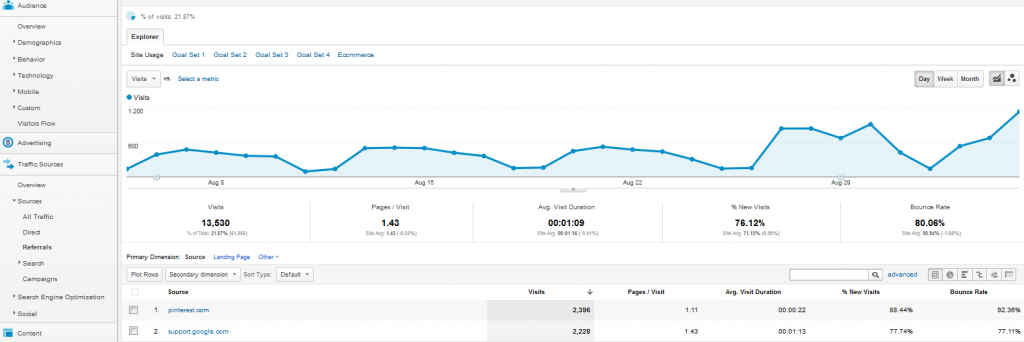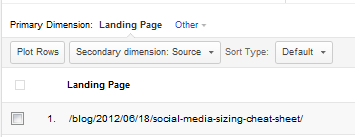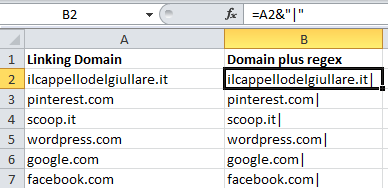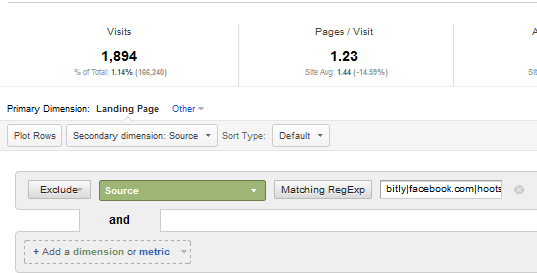Analyzing Traffic From Inbound Links In Google Analytics
In SEO, backlinks are a highly prized commodity. Many valuate a potential link almost completely on the basis of anchor text and estimates of “link juice.” However, these factors alone don’t fully reflect a links’ potential value.
Inbound links have the potential to be an important source of targeted traffic. And the role of backlinks in driving traffic is more important than ever because search engines, as they continue to evolve continue to de-emphasize the quantity of backlinks in favor of relevance and quality , (as evidenced in the Penguin update). In addition to being low-risk, backlinks from relevant quality pages are much more likely to pass traffic.
Despite inbound links potential as direct traffic drivers, many SEO practitioners continue to view links solely as a means to an ends, rather than the potentially valuable gateways to direct traffic they truly are. This line of thinking could lead one to ignoring great link opportunities. A link from Wikipedia is “nofollow” and therefore not “juicy”, but it can drive a great deal of traffic. A link from a site that already links a few times will not help search engine rankings much, but that link is still worth it if it passes traffic. Such opportunities are missed when we do not look at backlinks as traffic generators.
The first step to getting the most out of your backlink traffic is analysis. Which types of links are driving good traffic and why? The rest of this article is devoted to analyzing backlink traffic via referring sources in Google Analytics.
Identifying which linking sites you want to look at
The first step in analysis is to figure out what you want to analyze. If you want to look at traffic from you’re SEO endeavors, you probably are not concerned with sites linking to you from advertising or social media. Sometimes the lines between social media, advertising, and SEO become a little blurry, so you may need to think this out a bit.
There are basically two methods for looking at inbound link traffic:
- Specific set of linking sites: Perhaps you have a list of 20 sites you’ve worked to acquire links from last month, and you want to look at the traffic from those sites.
- All referring sites except particular groups: Perhaps Traffic from affiliates, advertising, and social media, and email are the responsibilities of other departments. If you know which sites are you don’t want look at, you can exclude said sites.
You can also combine these ways of looking at backlink traffic to gain deeper insight.
Pulling Referral Traffic Data in GA
We’re going to walk through pulling up data on link traffic in Google Analytics for both of the aforementioned methods. But first, since both methods of looking at backlink traffic will require you to pull the referral traffic segment, let’s review how to do that.
Referral traffic is all visitors who clicked a link from another site, with the exception of search engines (and links from campaigns that you manually tagged). If you’re working with a smaller site with a limited number of referring sites profile, then you may be able to skip the fancy tricks and just pull all referral traffic and analyze from there.
To look at referral traffic, first go to the “Standard Reporting” screen. You then click the “referrals” link in the left sidebar, found at Traffic Sources-> Sources-> Referrals.

Finding traffic for a specific set of linking sites
Example 1: a small set
Let’s suppose LunaMetrics wants to look at the traffic from a specific set of sites Lunametricians have published articles in: mashable.com, marketingpilgrim.com, allfacebook.com, and socialmediatoday.com.
To filter this set of sites, pull referral traffic, then set the advanced filter to filter only sources that match this Regular Expression (matching RegEx): mashable.com|marketingpilgrim.com|allfacebook.com|socialmediatoday.com

*The pipes (|) here basically represent the “or” operator and tell Google to match the character strings on either side of the pipes. To learn more about how pipes and other RegEx characters work in GA, see Robbin’s E-book on Regular Expressions.
Example 2: referrals to a specific page(s)
Suppose you have a great piece of link bait, and you want to look at the traffic action from those links. For our example, I’ll look at our most successful link bait this year —Dan’s Social Media Photo Sizing Cheat Sheet.
We’re going to look at referral traffic for just that page. An easy way is to switch our primary dimension to “Landing Page”. Then, we’ll set the “Secondary Dimension” as source. In this example, we selected a specific post as the landing page. Alternative you can filter an entire group of landing pages; for example, you could select all landing pages containing “blog”.

Example 3: a bigger specific set of links
You might want to look at a set of linking sites too big to manually type up practically. Let’s suppose we want to import links from a crawl tool. I’ll stick with the same example for the heck of it.
In this example, we get the linking domains from Google Webmaster Tools. If you’re logged into GWT, you’ll first go to the page on “Links to Your Site, found under “Traffic” in the left nav. Then, we click on the landing page we want, and we see that we’re given a list of domains linking to that page. Then we’re going to download those links.

Then, we’ll take our spreadsheet and prep the links for input into the GA filters. Note that you can duplicate this step regardless of where you got your big set of links. Remember the pipes in RegEx? We’re going to add the pipes to the right of the linking domain names with the concatenate function (the ampersand operator). We’ll need to delete the last pipe so that the last domain has no pipe to the right of it (otherwise GA will match also pull matches for nothing (which means you get everything.)

Then we need to add all the rows together in column B so that they are on one line. I like to paste the selection into Notepad++ and use the Join Lines feature.
Finally, we’re going take our string and paste in the advanced filter to again filter only sources that match this Regular Expression.
At this point, the savvy reader might say, “This example kind of sucked”. They’d be right on two counts. First, Analytics sometimes can’t handle really long RegEx strings (I actually had to break this particular string in two parts to get GA to take it). Second, when looking at a single page, pulling all the links you can find to a single page doesn’t really give you a whole lot more insight than simply pulling up the referrals to that page, as in Example 2.
I’ll offer that savvy reader a 2-part response. First, the method used in this example is what is useful and versatile: you can apply the method to any large specific set of links such as: all manually built links being monitored, all promotional partners, all links with a certain key phrase in the anchor text, all links following a big press release, etc…
Second, I want to thank you, savvy reader, for providing a nice segue into our final example…
Example 4: filtering a group of sites out
Let’s suppose we want to filter out some of the referring sites to our landing page. Let’s filter out social media sites we’re active on, our common url-shortening domains, and e-mail service providers. You can export the list of referring sites to excel to make it easier to sort through if you’d like. We’ll list the root domains to the url-shorteners and social media sites (except for Google plus, for which we’ll need to use a subdomain) and simply use “mail” to nab account for e-mail campaign traffic. Our string looks something like this:
bitly|facebook.com|hootsuite.com|linkedin.com|pinterest.com|plus.url.google.com|reddit.com|stumbleupon.com|t.co|tinyurl.com|mail
Now we’ll just plug our string in the advanced filter again, but this time we filter out sources that match this Regular Expression.

Using the methods illustrated in these four examples, you should be able to look at a wide variety of backlink groups to a variety of pages. Pay attention to specific link-building and link-baiting campaigns, types and niches of linking sites, and linking sites with high quality traffic. There are so many insights to be gained here that it would require another blog post to discuss in depth.
##What are some insights you’ve gained by looking at backlink traffic?


